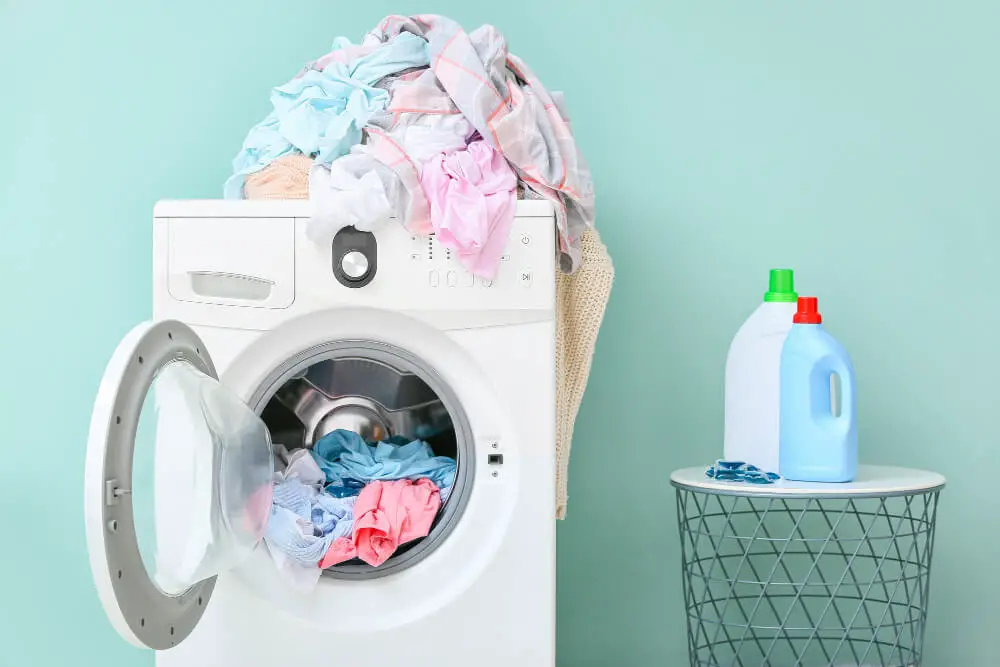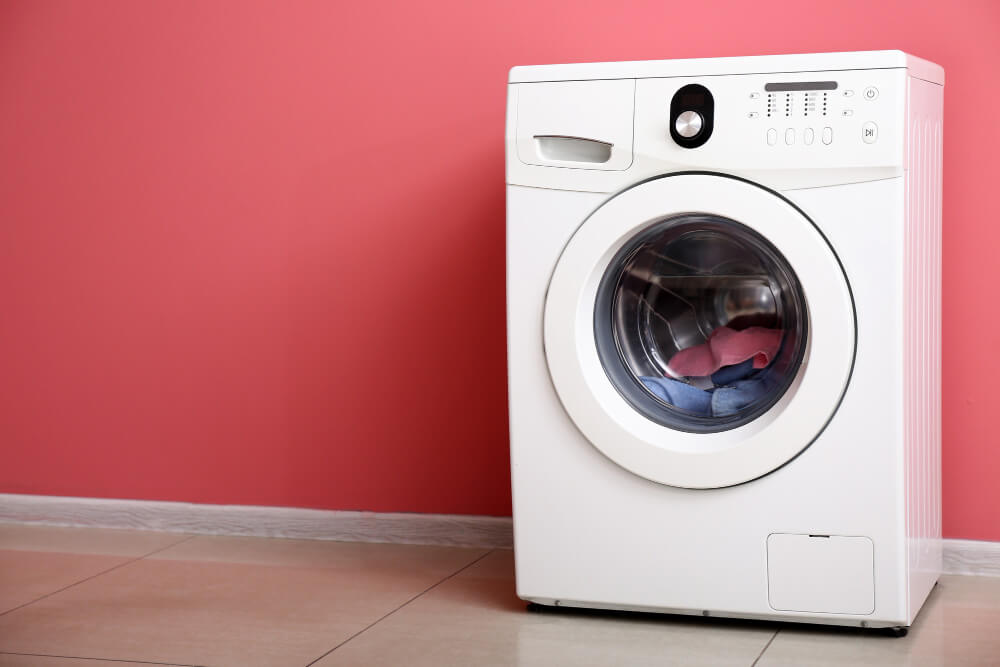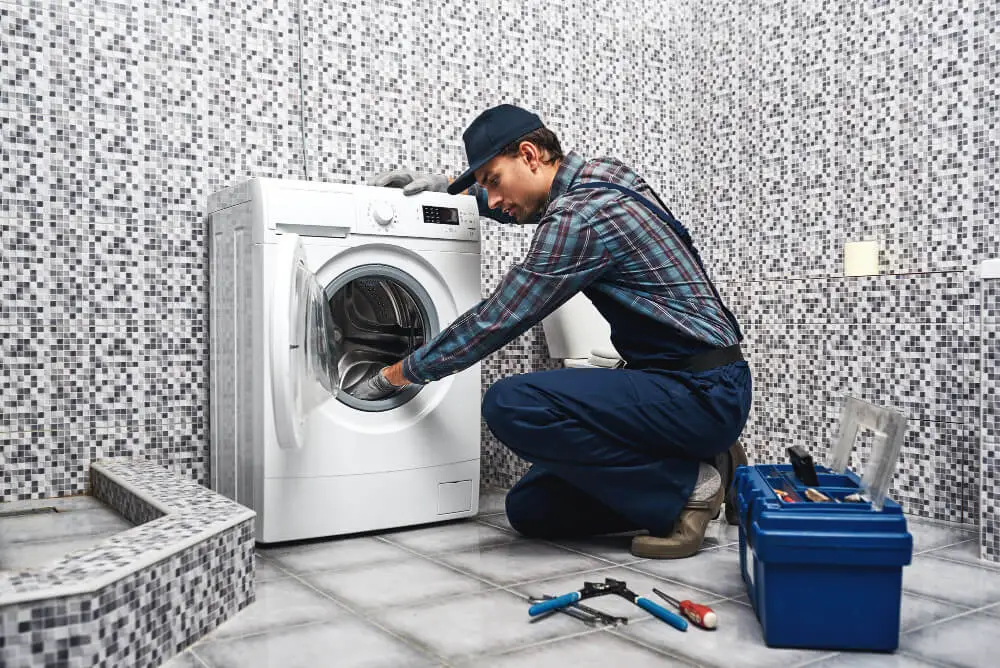Last Updated on August 8, 2023 By Emma W. Thomas
A moderately-priced washing machine that is mostly found in households flaunts a motor having the following specifications.
- Single Phase Motor
- Its speed is around the 1300-1400 RPM mark.
- Its power rating is around 5-6 HP.
- The voltage rating is 220 V.
- Its dimension is that of a regular one with a 1-inch height, weighing around 2-3 kgs.
Types Of Motor Used In Washing Machines

The motor is undeniably the principal part when it comes to the operability of the washing machine. Technically, it is in charge of converting the electrical energy into sufficient amounts of mechanical energy required to wash the load inside the bucket. Standard washing machines have been in use since the late 90s, and with time they have developed considerably. Newer features have enabled washing machines to become more than what they were intended to be initially. Yet, the basic functions of wash, rinse, and spin remain similar.
Coming back to the motor being used inside the washing machine, primarily washing machines have been using the single-phase AC synchronous motor and the split-phase induction motor. Both these variants have been used extensively in a large range of washing machines and have their own ways of functioning.
Let us discuss briefly each.
1. Split Phase Induction Motor
a) A split-phase induction motor has a wide area of applications, the washing machine being one of the major ones. The significant features of a split induction motor are given below.
b) The split-phase induction motor starts at 150 to 200 percent of the full load torque associated with a starting current of 6 – 9 times the full load current.
c) The start winding is composed of fine wire. Hence the density of the current flow is high and causes the winding to heat up rapidly. In cases where the starting period crosses 5 seconds, the winding runs the risk of burning out. This is then protected by a built-in thermal relay. That is why split-phase motors are best suited for applications where the starting periods aren’t much frequent.
d) Split-phase induction motors are cheaper and hence very popular in the market.
e) These are, in essence, constant-speed motors with a variation of 2-4 percent ranging from no load to full load.
f) In applications where the starting torque required is moderate and the starting time periods are abrupt and infrequent, these motors serve the purpose best. The best examples of their applications are oil burners, fans, machine tools of small sizes, and of course, washing machines.
g) Their power ratings are usually within the range of 60-250 W.
2. Single Phase AC Synchronous Model
In the case of a single-phase synchronous motor the current flow through the coil as well as the back emf changes with respect to the speed of the rotating motor. When it is at lower rotational speeds the back emf is small and hence a large current flows through the motor coils causing a magnetic saturation inside the magnetic circuit. These motors are brushless and do not need an inverter. Hence these are low in cost as well and find extensive applicability.
How Does The Usual Washing Machine Motor Work?
The usual electric motors being used in washing machines deploy the common attraction and repulsion of magnetic fields while operating. Older models use induction motors, which are driven through a gearbox. Modern machines use motors having permanent magnet field poles, which are controlled with the help of a microprocessor. The microprocessor facilitates easy speed and direction control of the motor. The permanent field poles are actually windings around the iron cores, which pass a current through each of those winding and, in turn, repel and attract the permanent magnets inside the rotor, making it rotate at the desired speeds.
Common Motor Issues That Make The Washing Machine Malfunctions
The motor of the washing machine is basically the central unit that is responsible for driving the entire device. Hence, if it fails to operate, nothing would essentially work. That is why most washing machine issues boil down to the motor as there is a strong chance that they are connected in some way or the other to the motor. It is pretty obvious as well because it is the motor that provides the necessary power to all the internally functional elements of the machine, such as the gearbox, the pump, the clutch, the agitator, etc.
The motor malfunctioning will cause most other parts to fall apart as well. We have provided the most common washing machine issues whose root causes are related to the motor of the machine.

1. Washer Failing To Pump Or/And Spin
The most common problem we occasionally face with the washer is that it fails to spin as well as pump the water in and out. This can occur while the motor is running and also when it is not. In the latter case, the problem might be with the lid switch. The lid switch is placed inside the machine near the frame of the door. Check it for defects, and if found, it might need replacement.
In some cases, the water might continue being pumped in and out, but the washer ceases to spin. This might also occur due to a defective lid switch. Another possible factor that might cause this is a damaged coupler. A coupler is a connector made of rubber or plastic that connects the transmission to the motor shaft. If the coupler breaks down, there are no other ways there than a replacement. The drive motor can also begin to malfunction and cause a similar problem. Drive motors are technically designed to move in opposite directions. There is a possibility that it can work in one direction and burn out while moving in the other. In case the drive motor fails, it also needs a replacement. Other possible culprits in this regard are the worn clutch or a broken belt.
2. Washer Fails To Agitate
The agitator of the washing machine is designed to move around the clothes before the spinning cycle begins. In some cases, the washer fails to agitate owing to a variety of things, including a worn clutch or belt, defective lid switch or damaged coupler inside the motor, failed pulley or drive motor, and even the transmission. If the clutch cable has worn out, one can notice black substances underneath the washer on the ground. This is an indication that the clutch requires to be replaced.
3. Clothes Not Drying Properly
The spin cycle leaves the clothes dry inside the washer after it terminates. If the washer malfunctions, it might cause the clothes to remain wet after the cycle. The motor coupler could possibly be the culprit in this case as well. It is also somewhat dependent on the brand of the washer. For Maytag brands, the cause could be a worn-out belt, while in the case of General Electric, it could be a worn-out clutch. Occasional variations might also be observed.
4. All The Cycles Facing Issues
When you observe each of the cycles throwing up some issue or the other, the chances are high that the drive motor is at fault. This would hence need to be replaced. In the case of General Electric washing machines, the automatic lever of the clutch might face failure and would need to be tended to by a technician.
Most issues with washing machines are usually confined to a few components only, especially the washer motor. The motor is responsible for driving the major components that allow the washer bucket to be filled up with water and then perform the other associated tasks such as drain, spin, and agitate. Smaller parts can be fixed by us, but larger issues might require an expert technician to look into and possibly replace the main component.
Common Issues And The Principal Faults
| Issues With Machine | Faults To Check |
| The Washer not pumping or spinning | The issue with the Lid switch |
| The Washer spinning but not pumping | Damaged coupler, drive motor, or lid switch. |
| Cycles facing issues | Defective drive motor |
| Washer failing to agitate | Worn-out clutch or belt, defective drive motor |
What Causes a Washing Machine Motor To Burn Out?
Washing machines are a crucial part of the modern household, but dealing with a burnt-out motor can be a frustrating experience. A motor can burn out for various reasons, some of which are preventable with proper care and maintenance. This article explores these causes in detail.
1. Overloading the Washing Machine
Overloading the washing machine on a regular basis can cause the motor to burn out sooner than expected. The extra weight and strain make the motor work significantly harder, leading to its premature failure.
2. Lack of Proper Ventilation
A washing machine requires enough space for air circulation to keep its components cool, especially the motor. A machine placed in a cramped or poorly ventilated space might cause the motor to overheat and consequently burn out.
3. Internal Component Failure
The washing machine’s internal components, such as capacitors and control panels, can cause motor damage if they malfunction. Investigators often check these parts when diagnosing a burnt-out motor.
| Cause of Burn-Out | Possible Solution |
|---|---|
| Overloading | Avoid overloading the washing machine |
| Poor Ventilation | Ensure proper placement and adequate ventilation |
| Internal Component Failure | Regular maintenance and early detection of faults |
4. Age and Wear and Tear
Like any other appliance, a washing machine motor has a limited lifespan. Over time, natural wear and tear can cause the machine’s components, including the motor, to burn out. Regular maintenance and timely replacement of worn-out parts can delay this inevitable occurrence.
5. Faulty Electrical Connections
Faulty electrical connections can lead to inconsistent power supply, forcing the motor to work harder. Over time, this might cause the motor to burn out. Be sure to check and replace any faulty electrical components promptly.
6. Improper Use of Detergent
Certain types of detergents can cause too many suds, making it harder for the motor to spin. Persistent use of these soaps can put a strain on the motor, leading to eventual burnout.
How much horsepower does a washing machine motor have?
The amount of force, or horsepower, that a motor provides will help determine how much water is pumped out, the temperature of the water coming out, and how fast the clothes are spun.
The motor typically has between 1-1.5 horsepower.
How to Use a Washing Machine Motor?
The washing machine motor makes it possible for the drum to spin around, which helps to clean the clothes by tumbling them around inside the tub. Apart from being important for clean clothes, a working washer motor also increases the longevity of your appliance. If you notice that your washer is having difficulty spinning at its normal speed, it may be time to call in a professional repair person.
What is the speed of a washing machine motor?
The motor is what helps power the tub and belt that moves the clothes through the washer. It can be rare for a motor to break down, but if yours needs replacing, it’s a pretty simple process.
What is the rpm of a washing machine motor?
Its rpm (revolutions per minute) is measured by using an internal tachometer. This device can be accessed through the manufacturer’s service manual. The tachometer output is fed to the con which regulates motor speed to provide a desired wash/spin cycle. The RPM of a washing machine motor is controlled by the motor’s internal tachometer.
Conclusion
The washing machine is arguably one of the most used household appliances and is of the utmost significance—the motor of the washing machine functions as the primary unit driving all its actions. Usually, older machines deploy a split-phase induction motor, which is a very common motor used in such appliances due to their cheap availability. In case the motor fails to function, then the washing machine is bound to throw up issues that will hinder the usual operability of the washing machine. Common washing machine issues owe their roots principally to the irregular functioning of the motor. They are mentioned above and hence can be taken care of.
References:
https://www.doityourself.com/stry/5-common-washing-machine-motor-problems
https://applianceteacher.com/what-causes-a-washing-machine-motor-to-burn-out
Emma is a graduate of Domestic Science or Family and Consumer Sciences (Home Economics) from the University of Wisconsin. She has 7 years of experience Working with the strategic section of BestBuy and now writing full-time for Homeeon.
From Managing the Home, Interiors, Cleaning, and Exteriors to Gardening and everything about Making A Home Liveable – is her passion and this Homeeon is the result of this.
Emma loves decorating her home with the best stuff found online. She cares about quality over anything and writes reviews about them here in Homeeon. Get in touch with her over Pinterest.
Keep reading her blogs.

